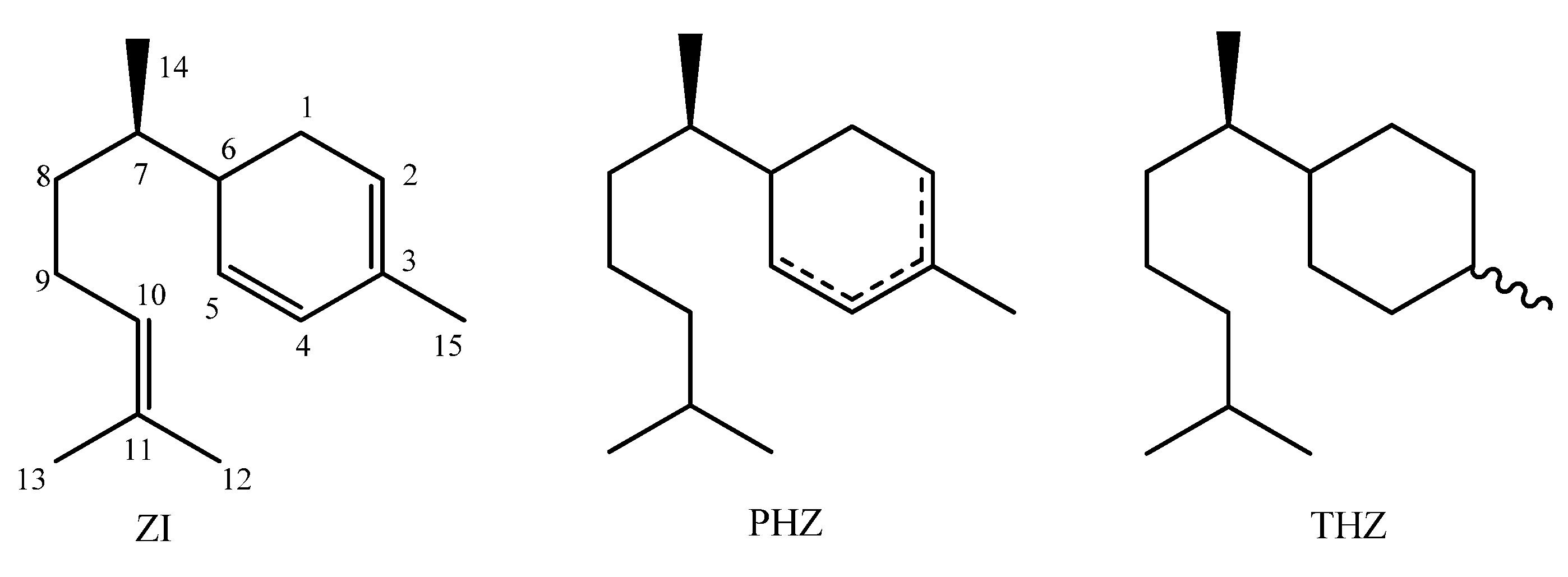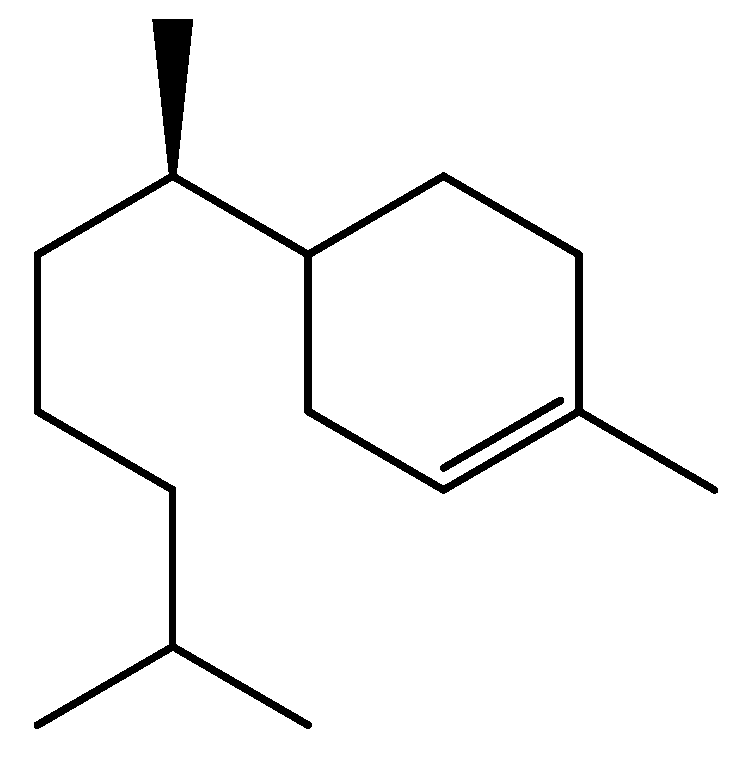Chemical Composition and Cytotoxicity Evaluation of Essential Oil from Leaves of Casearia Sylvestris, Its Main Compound α-Zingiberene and Derivatives
Abstract
:1. Introduction
2. Results and Discussion
| Compound | KI | % Composition |
|---|---|---|
| δ-elemene | 1339 | 0.29 |
| α-copaene | 1376 | 0.20 |
| β-elemene | 1391 | 2.19 |
| α-cis-bergamotene | 1415 | 0.24 |
| E-caryophyllene | 1418 | 14.27 |
| gurjunene | 1432 | 0.16 |
| α-guaiene | 1439 | 1.50 |
| α-humulene | 1454 | 1.68 |
| α-patchoulene | 1456 | 1.08 |
| α-acoradiene | 1463 | 4.11 |
| β-acoradiene | 1466 | 2.30 |
| γ-muurolene | 1477 | 5.16 |
| viridiflorene | 1493 | 5.07 |
| α-zingiberene | 1495 | 48.31 |
| β-trans- guaiene | 1500 | 1.33 |
| 7-epi-α-selinene | 1517 | 1.05 |
| δ-cadinene | 1524 | 1.33 |
| germacrene B | 1556 | 0.39 |
| khusimone | 1593 | 0.25 |
| 10-epi-γ-eudesmol | 1619 | 0.35 |
| 1-epi-cubenol | 1627 | 0.51 |
| α-muurolol | 1645 | 3.72 |
| α-cadinol | 1653 | 3.24 |
| TOTAL | 98.73 |


| Sample | A2058 | HeLa | MCF-7 | U-87 | Siha | HL60 | B16F10 Nex2 |
|---|---|---|---|---|---|---|---|
| Crude oil | 41.1 ± 2.0 | 29.0 ± 0.0 | 42.2 ± 3.4 | 27.1 ± 1.5 | 23.9 ± 0.46 | 12.0 ± 1.9 | 61.5 ± 1.8 |
| ZI | >200 | 63.2 ± 2.7 | >200 | 153.0 ± 29.9 | 48.0 ± 0.8 | 98.7 ± 9.7 | 27.0 ± 1.2 |
| PHZ | >200 | >200 | >200 | >200 | 160 | >200 | 65.2 ± 1.1 |
| THZ | 64.1 ± 3.0 | 65.6 ± 1.4 | 131.3 ± 10.0 | 59.4 ± 3.5 | 54.9 ± 2.8 | 34.3 ± 0.9 | >200 |
| Cisplatin (control) | nd | 20.3 ± 1.20 | nd | 44.9 ± 6.0 | 59.8 ± 0.0 | 20.9 ± 1.50 | 52.6 ± 4.49 |
3. Experimental
3.1. Plant Material
3.2. Essential Oil Extraction and Analysis
3.3. Chromatographic Separation Procedures
3.4. Hydrogenation of α-zingiberene

3.5. Cell Lines
3.6. In Vitro Cytotoxic Activity
4. Conclusions
Acknowledgments
Conflicts of Interest
References
- Azuma, T.; Kajita, T.; Yokoyama, J.; Ohashi, H. Phylogenetic relationships of Salix (Salicaceae) based on RBCL sequence data. Amer. J. Bot. 2000, 87, 67–75. [Google Scholar] [CrossRef]
- Souza, V.C.; Lorenzi, H. Botânica Sistemática: Guia Ilustrado Para Identificação das Famílias de Angiosperma da Flora Brasileira, Baseado Em APGII; Instituto Plantarum: Nova Odessa, Brazil, 2005. [Google Scholar]
- Joly, A.B. Botânica: Introdução À Taxonomia Vegetal, 12th ed.; Companhia Editora Nacional: São Paulo, Brazil, 1998. [Google Scholar]
- Lorenzi, H.; Matos, F.J.A. Plantas Medicinais Do Brasil: Nativas E Exóticas; Instituto Plantarum: Nova Odessa, Brazil, 2008. [Google Scholar]
- Ferreira, P.M.P.; Costa-Lotufo, L.V.; Moraes, M.O.; Barros, F.W.A.; Martins, A.M.A.; Cavalheiro, A.J.; Bolzani, V.S.; Santos, A.G.; Pessoa, C. Folk uses and pharmacological properties of Casearia sylvestris: A medicinal review. Anais da Academia Brasileira de Ciências 2011, 83, 1373–1384. [Google Scholar] [CrossRef]
- Talapatra, S.K.; Canguly, N.C.; Goswami, S.; Talapatra, B. Chemical constituents of Casearia graveolens: Some novel reactions and the preferred molecular conformation of the major coumarin, micromelin. J. Nat. Prod. 1983, 46, 401–408. [Google Scholar] [CrossRef]
- Rojas-Sepúlveda, A.M.; Mendieta-Serrano, M.; Mojica, M.Y.A.; Salas-Vidal, E.; Marquina, S.; Villarreal, M.L; Puebla, A.M.; Delgado, J.I.; Alvarez, L. Cytotoxic podophyllotoxin type-lignans from the steam bark of Bursera fagaroides var. fagaroides. Molecules 2012, 17, 9506–9519. [Google Scholar] [CrossRef]
- Gordaliza, M.; Castro, M.A.; del Corral, J.M.; Feliciano, A.S. Antitumor properties of podophyllotoxin and related compounds. Curr. Pharm. Des. 2000, 6, 1811–1839. [Google Scholar] [CrossRef]
- Shaari, K.; Waterman, P.G. Podophyllotoxin-type lignans as major constituents of the stems and leaves of Casearia clarkei. J. Nat. Prod. 1994, 57, 720–724. [Google Scholar] [CrossRef]
- Borges, F.; Roleira, F.; Milhazes, N.; Santana, L.; Uriarte, E. Simple coumarins and analogues in medicinal chemistry: occurrence, synthesis and biological activity. Curr. Med. Chem. 2005, 12, 887–916. [Google Scholar] [CrossRef]
- Vieira-Júnior, G.M.; Dutra, L.A.; Ferreira, P.M.P.; Moraes, M.O.; Costa Lotufo, L.V.; Pessoa, C.O.; Torres, R.B.; Boralle, N.; Bolzani, V.S.; Cavalheiro, A.J. Cytotoxic clerodane diterpenes from Casearia rupestris. J. Nat. Prod. 2011, 74, 776–781. [Google Scholar] [CrossRef]
- Williams, R.B.; Norris, A.; Miller, J.S.; Birkinshaw, C.; Ratovoson, F.; Andriantsiferana, R.; Rasamison, V.E.; Kingston, D.G.I. Cytotoxic Clerodane diterpenoids and their hydrolysis products from Casearia nigrescens from the Rainforest of Madagascar. J. Nat. Prod. 2007, 70, 206–209. [Google Scholar] [CrossRef]
- Whitson, E.L.; Thomas, C.L.; Henrich, C.J.; Sayers, T.J.; McMahon, J.B.; McKee, T.C. Clerodane diterpenes from Casearia arguta that act as synergistic TRAIL sensitizers. J. Nat. Prod. 2010, 73, 2013–2018. [Google Scholar] [CrossRef]
- Itokawa, H.; Totsuka, N.; Takeya, K.; Watanabe, K.; Obata, E. New antitumor principles, casearins A–F, from Casearia sylvestris Sw. (Flacourtiaceae). Chem. Pharm. Bull. 1998, 36, 1585–1588. [Google Scholar]
- Morita, H.; Nakayama, M.; Kojima, H.; Takeya, K.; Itokawa, H.; Ichenkel, E.P.; Motidome, M. Structures and cytotoxic activity relationship of casearins, new clerodane diterpenes from Casearia sylvestris Sw. Chem. Pharm. Bull. 1991, 39, 693–697. [Google Scholar] [CrossRef]
- Oberlies, N.H.; Burgess, J.P.; Navarro, H.A.; Pinos, R.E.; Fairchild, C.R.; Peterson, R.W.; Soejarto, D.D.; Farnsworth, N.R.; Kinghorn, A.D.; Wani, M.C.; et al. Novel bioactive clerodane diterpenoids from the leaves and twigs of Casearia sylvestris. J. Nat. Prod. 2002, 65, 95–99. [Google Scholar] [CrossRef]
- Carvalho, P.R.F.; Furlan, M.; Young, M.C.M.; Kingston, D.G.I.; Bolzani, V.S. Acetylated DNA damaging clerodane diterpenes from Casearia sylvestris. Phytochemistry 1998, 49, 1659–1662. [Google Scholar] [CrossRef]
- Santos, A.G.; Perez, C.C.; Tininis, A.G.; Bolzani, V.S.; Cavalheiro, A.J. Clerodane diterpenes from leaves of Casearia sylvestris Swartz. Quim. Nova 2007, 30, 1100–1103. [Google Scholar] [CrossRef]
- Wang, W.; Zhao, J.; Wang, Y.H.; Smillie, T.A.; Li, X.C.; Khan, I.A. Diterpenoids from Casearia sylvestris. Planta Med. 2009, 75, 1436–1441. [Google Scholar] [CrossRef]
- Carvalho, E.S.; Santos, A.G.; Cavalheiro, A.J. Identificação de diterpenos clerodânicos em diferentes órgãos de Casearia sylvestris Swartz. Rev. Cienc. Farm. 2009, 30, 277–284. [Google Scholar]
- Tininis, A.G.; Assonuma, M.M.; Telascrea, M.; Perez, C.C.; Silva, M.R.S.R.M.; Favoreto, R.; Cavalheiro, A.J. Composição e variabilidade química de óleo essencial de Casearia sylvestris SW. Rev. Bras. Pl. Med. 2006, 8, 132–136. [Google Scholar]
- Silva, S.L.; Chaar, J.S.; Figueiredo, P.M.S.; Yano, T. Cytotoxic evaluation of essential oil from Casearia sylvestris Sw on human cancer cells and erythrocytes. Acta Amazonia 2008, 38, 107–112. [Google Scholar] [CrossRef]
- Lago, J.H.G.; Souza, E.D.; Mariane, B.; Pascon, R.; Vallim, M.A.; Martins, R.C.C.; Baroli, A.A.; Carvalho, B.A.; Soares, M.G.; Santos, R.T.; et al. Chemical and biological evaluation of essential oils from two species of myrtaceae—Eugenia uniflora L. and Plinia trunciflora (O. Berg) Kausel. Molecules 2011, 16, 9827–9837. [Google Scholar] [CrossRef]
- Sartorelli, P.; Santana, J.S.; Guadagnin, R.C.; Lago, J.H.G.; Pinto, E.G.; Tempone, A.G.; Stefani, H.A.; Soares, M.G.; Silva, A.M. In vitro trypanocidal evaluation of pinane derivatives from essential oils of ripe fruits from Schinus terebinthifolius raddi (Anacardiaceae). Quim. Nova 2012, 35, 746–747. [Google Scholar]
- Santana, J.S.; Sartorelli, P.; Guadagnin, R.C.; Matsuo, A.L.; Figueiredo, C.R.; Soares, M.G.; Silva, A.M.; Lago, J.H.G. Essential oils from leaves of Schinus terebinthifolius Raddi (Anacardiaceae)—Chemical composition and in vitro cytotoxicity evaluation. Pharm. Biol. 2012, 50, 1248–1253. [Google Scholar] [CrossRef]
- Silva, E.B.P.; Matsuo, A.L.; Figueiredo, C.R.; Chaves, M.H.; Sartorelli, P.; Lago, J.H.G. Chemical constituents and cytotoxic evaluation of essential oils from leaves of Porcelia macrocarpa R.E. Fries (Annonaceae). Nat. Prod. Commun. 2013, 8, 277–279. [Google Scholar]
- Ismail, M.; Bagalkotkar, G.; Iqbal, S.; Adamu, H.A. Anticancer properties and phenolic contents of sequentially prepared extracts from different parts of selected medicinal plants indigenous to Malaysia. Molecules 2012, 17, 5745–5756. [Google Scholar] [CrossRef]
- Adams, R.P. Identification of Essential Oil Components by Gas Chromatography/Mass Spectroscopy, 4th ed.; Allured: Carol Stream, IL, USA, 2007. [Google Scholar]
- Esteves, I.; Souza, I.R.; Rodrigues, M.; Cardoso, L.G.V.; Santos, L.S.; Sertiè, J.A.A.; Perazzo, F.F.; Lima, L.M.; Schneedorf, J.M.; Bastos, J.K.; et al. Gastric antiulcer and anti-inflamatory activities of the essential oil from Casearia sylvestris Sw. J. Ethnopharmacol. 2005, 101, 191–196. [Google Scholar] [CrossRef]
- Becker, C. Avaliação da atividade acaricida de óleos essenciais de Acanthospermum australe (Loefl.) O. Kuntze, Casearia sylvestris Sw e Pothomorphe umbellata (L.) Miq., em Tetranychus urticae Koch, 1836 (Acari: Tetranychidae). Mestrado Dissertação, Centro Universitário Univates, Lajeado, Brazil, 2008. [Google Scholar]
- Gobbo-Neto, L.; Lopes, N.P. Plantas medicinais: fatores de influência no conteúdo de metabólitos secundários. Quim. Nova 2007, 30, 374–381. [Google Scholar] [CrossRef]
- Beek, T.A.; Lelyveld, G.P. Isolation and identification of five major sesquiterpene hydrocarbons of ginger. Phytochem. Anal. 1991, 2, 26–34. [Google Scholar] [CrossRef]
- Breeden, D.C.; Coates, R.M. 7-Epizingiberene, A novel bisabolane sesquiterpene from wild tomato leaves. Tetrahedron 1994, 50, 11123–11132. [Google Scholar] [CrossRef]
- Salvador, M.J.; Wisniewski, J.A.; Kassuy, C.A.L.; Santos, E.P.; Riva, D.; Stefanello, M.E.A. Chemical composition and cytotoxic activity of the essential oil from the leaves of Casearia lasiophylla. Rev. Bras. Farmacogn. 2011, 21, 864–868. [Google Scholar] [CrossRef]
- Bazhenov, Y.P.; Kas’yanova, L.Z.; Bokin, A.I.; Kutepov, B.I.; Khazipova, A.N.; Travkin, E.A.; Shchadneva, N.A.; Khusnutdinov, R.I.; Dzhemilev, U.M. Hydrogenation and skeleton rearrangements of α-pinene on heterogeneous catalysts. Russ. J. App. Chem. 2003, 76, 232–237. [Google Scholar]
- Mosmann, T. Rapid colorimetric assay for cellular growth and survival: Application to proliferation and cytotoxicity assays. J. Immunol. Methods 1983, 65, 55–63. [Google Scholar] [CrossRef]
- Sample Availability: Samples of the compounds α-zingiberene, PHZ and THZ are available from the authors.
© 2013 by the authors; licensee MDPI, Basel, Switzerland. This article is an open access article distributed under the terms and conditions of the Creative Commons Attribution license (http://creativecommons.org/licenses/by/3.0/).
Share and Cite
Bou, D.D.; Lago, J.H.G.; Figueiredo, C.R.; Matsuo, A.L.; Guadagnin, R.C.; Soares, M.G.; Sartorelli, P. Chemical Composition and Cytotoxicity Evaluation of Essential Oil from Leaves of Casearia Sylvestris, Its Main Compound α-Zingiberene and Derivatives. Molecules 2013, 18, 9477-9487. https://doi.org/10.3390/molecules18089477
Bou DD, Lago JHG, Figueiredo CR, Matsuo AL, Guadagnin RC, Soares MG, Sartorelli P. Chemical Composition and Cytotoxicity Evaluation of Essential Oil from Leaves of Casearia Sylvestris, Its Main Compound α-Zingiberene and Derivatives. Molecules. 2013; 18(8):9477-9487. https://doi.org/10.3390/molecules18089477
Chicago/Turabian StyleBou, Diego Dinis, João Henrique G. Lago, Carlos R. Figueiredo, Alisson L. Matsuo, Rafael C. Guadagnin, Marisi G. Soares, and Patricia Sartorelli. 2013. "Chemical Composition and Cytotoxicity Evaluation of Essential Oil from Leaves of Casearia Sylvestris, Its Main Compound α-Zingiberene and Derivatives" Molecules 18, no. 8: 9477-9487. https://doi.org/10.3390/molecules18089477




